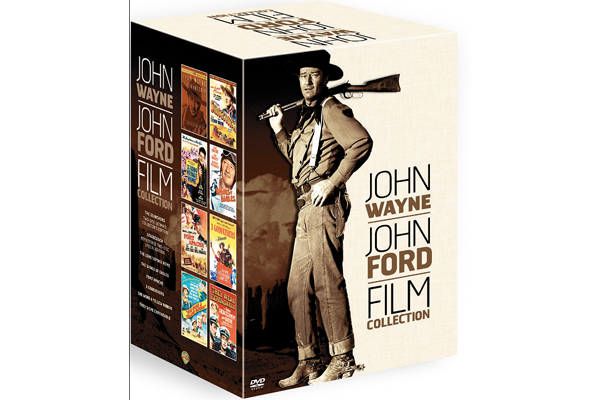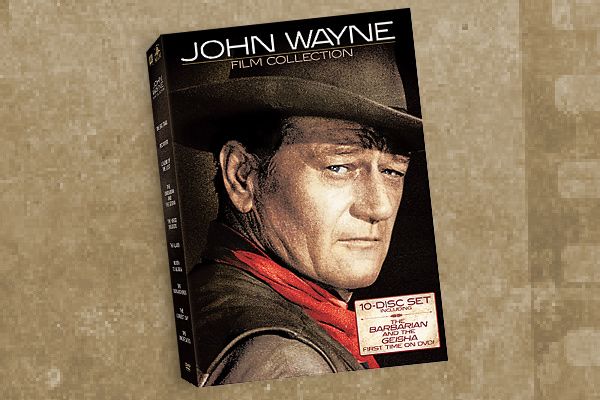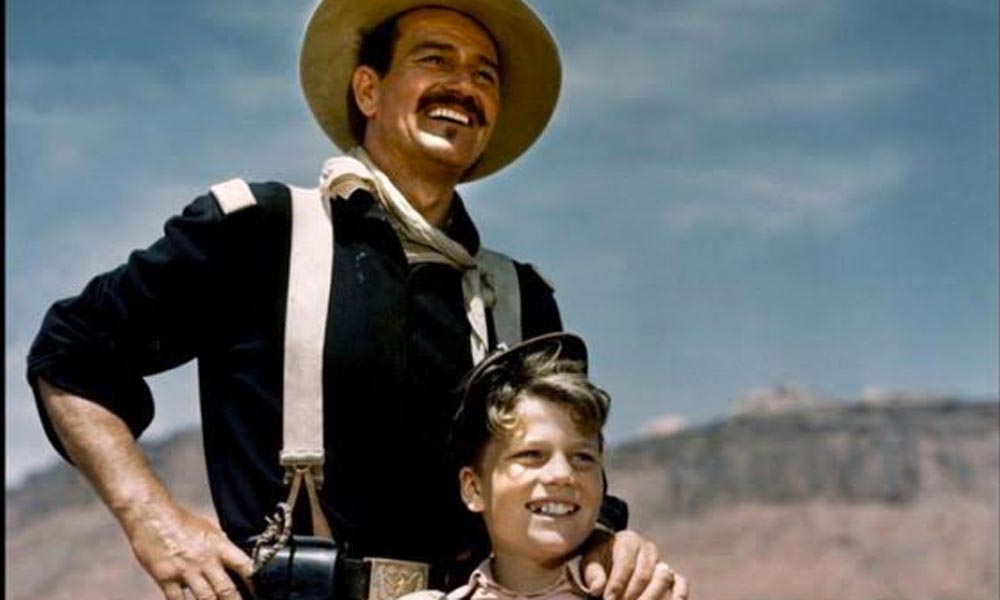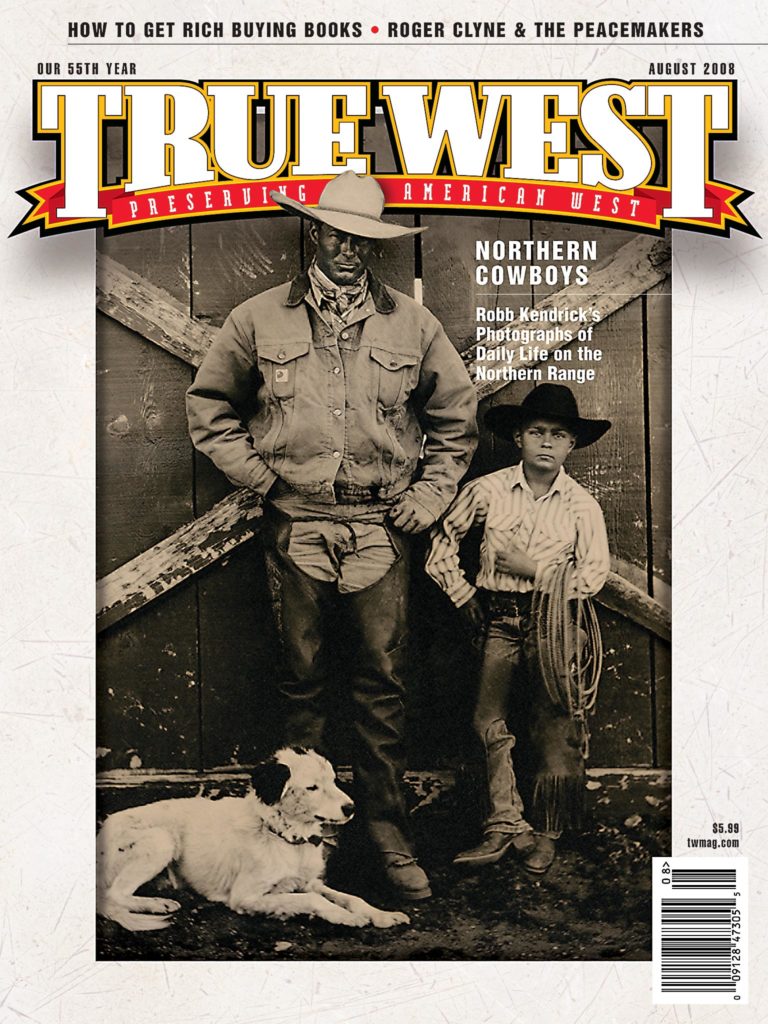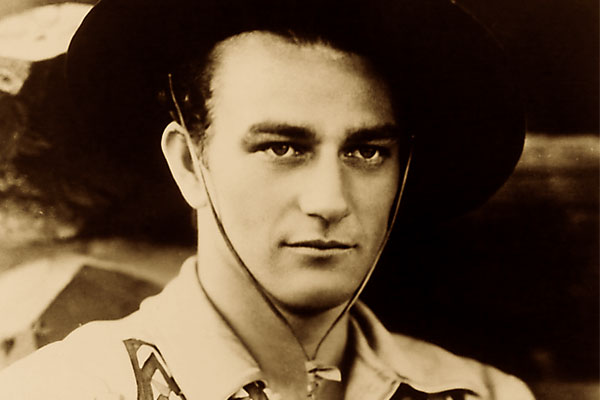
The Big Trail (1930) succeeded in recreating, from the widest vistas to the smallest details, the saga of those men, women and children who crossed and populated the new frontier in the mid-1800s.
The movie also did everything any film could have done to launch the career of a major star, in this case, the young John Wayne in his first major screen appearance.
Notwithstanding the quality of the picture and the presence of the Duke, The Big Trail is one of the most impressive Westerns in movie history, seen by the fewest people.
Directed by Raoul Walsh, the movie tells the story of a huge wagon train crossing thousands of miles from the Mississippi to a valley in Washington State. To make the film, Walsh employed 20,000 extras and 93 principal actors. He used 725 natives from five different Indian tribes acting as scouts and, in one amazing sequence, hostiles, and the picture made use of 185 wagons, 1,800 cows, 1,400 horses, 500 buffalos and, we are told, 700 chickens, pigs and dogs. It’s probably safe to assume that some of the additional crew of 200 were carrying shovels and buckets.
They filmed the movie for four months across 4,300 miles and seven different states. If all that wasn’t enough, they shot, simultaneously, two different English-language versions, and, since dubbing as we know it was not yet technically possible, they also filmed separate versions for Spanish, Italian and German audiences with entirely different casts.
Of course none of this would be particularly memorable were it not for the fact that the movie is a fantastically entertaining spectacle, containing a staggering amount of choreography and minutiae—every frame loaded with multiple layers of detail and activity. One of the primary reasons that so few people have seen the film as it was intended is that The Big Trail is one of the first widescreen films ever made, and director Walsh took full advantage of the size and scope that the 70mm film afforded him.
Twenty years before CinemaScope, Fox called it the “Grandeur Process.” The problem was, theaters weren’t equipped to show the picture, and the very recent stock market crash made capital-devouring experiments of this sort a bad idea.
The movie in its full widescreen format was only seen briefly in New York and Los Angeles. The rest of the country saw a standard-sized 35mm version, which was still pretty terrific, but nothing like the original. When the film didn’t connect, it cost Fox dearly. One could almost say it took Shirley Temple to cure Fox from their delusions of Grandeur.
As to why it didn’t do better at the box office, perhaps the film was too long at 122 minutes, and maybe the story was episodic and unfocused. Could be that audiences were put off by the central villain, who, as played by Tyrone Power, Sr., was an unbearable and repellent tub of bluster and grunts—a kind of pre-Popeye Bluto who serves as the trail boss, but who is looking to kill Wayne before Wayne kills him.
Or maybe John Wayne, as a young frontiersman wearing a white Elvis-like buckskin jumpsuit, wasn’t yet strong enough to hold the center of a picture this big.
Whatever the case, Wayne, who had only appeared in small parts or as an extra in a handful of silent films prior to The Big Trail, went back to relative anonymity in
B-Westerns. Not until 1939, when director John Ford’s Stagecoach was released, would he secure a handhold in the film industry as a true leading man.
Most biographers believe that Ford had plans for Wayne, but that the famously spiteful director put him on industry ice when Wayne let himself be plucked off the backlot by Walsh, who gave Wayne his stage name, by the way, for The Big Trail. They believe that Ford managed to keep Wayne in B-movie limbo or, at the very least, refused to consider him for parts in the A-level films he was making at the time.
True or not, even if Ford had cast Wayne in this or that film through the early to mid-1930s, stardom was something that would take its time for Wayne, until the right parts, the right physical heft and the right audiences all came together for the kid.
The truth is, Wayne’s real ascension came in a series of stages, beginning with Stagecoach and running through Howard Hawks’s Red River, Allan Dwan’s Sands of Iwo Jima and Ford’s cavalry trilogy. Wayne didn’t hit full stride until the late 1940s; from then on, he was the Wayne we remember today.
Still, no young unknown has ever been given a better entrance into the big time than Wayne had with The Big Trail. It’s fascinating to watch the movie that might have, and somehow didn’t, put Wayne on the fast track to superstardom.
Every bit as fascinating is the film itself, because The Big Trail is, in its own way, a failed star of a picture. The movie’s strengths far outdistance its faults, and it’s all got to do with Walsh.
One of Hollywood’s greatest directors, Walsh never quite gained the recognition of better known filmmakers of the era like John Ford, Howard Hawks and Alfred Hitchcock, even though his body of work puts him in that tier. The irony is, Walsh was there before any of the others. He played John Wilkes Booth in D.W. Griffith’s The Birth of a Nation (1913), and he was on the scene as an assistant, as a director and as an actor with Pancho Villa in Mexico (1912-14).
Walsh came to filmmaking with a cowboy heritage; his skill with a horse got him into pictures in the first place. Because of that heritage, you’ll find an authenticity in The Big Trail that is rare enough in most Westerns. If only there was a “making of” featurette that could have captured it all.
The best documentarian for a job of that sort would have been Richard Schickel, who knew and filmed Raoul Walsh as part of his series “The Men Who Made the Movies” in the early 1970s, which also included segments on Howard Hawks, King Vidor and Alfred Hitchcock.
Since that time, Schickel has written innumerable reviews and essays on film for Time magazine and The Los Angeles Times, and has authored books on Walt Disney, Marlon Brando, Clint Eastwood and, more recently, Elia Kazan.
This fall, Mr. Schickel’s multi-part history of Warner Brothers, You Must Remember This: The Warner Bros. Story, narrated by Clint Eastwood, will be seen on PBS as part of the “American Masters” series.
Schickel also provided commentary for the latest DVD edition of The Big Trail. The two-DVD set also offers short pieces on Walsh, Wayne, the Grandeur Process and the two separate English-language versions of the film, in widescreen and 35mm.
True West interviewed Mr. Schickel for his insights into The Big Trail, John Wayne and Raoul Walsh.
TW: Reading Walsh’s autobiography (Each Man In His Time: The Life Story of a Director), he seemed like a great guy—
RS: Raoul was a wonderful man, a fabulous character and a delightful human being.
Do you think he’s underappreciated?
I think he’s a little bit overlooked; not so much overseas. He was kind of revered in France, and I think some of the other European cinephile countries…. I honestly believe that “The Men Who Made the Movies” and subsequent attention he’s received on Turner Classic Movies has given him a little bit more of a historical presence now than he had 30 to 40 years ago. There are people, you know, significant people like David Thomson, the film encyclopedist, who [are] very high on Raoul’s work. Yeah, he could use more exposure, because the films are so good.
In that Ford/Hawks/Walsh universe, Thomson is firmly on the Walsh/Hawks side.
I also have kind of mixed feelings about Ford. There are wonderful images in his films, and there are several of them I think are very good, but there are a number of them that to me are not so hot, or for which I have very ambivalent feelings. The Searchers, for example—I see its merits, but I also see serious defects in it.
That might have something to do with how each of them deals with sentiment—Ford can be hard to bear at times, but in a movie like Gentleman Jim, Walsh can rip your heart right out with little effort.
Absolutely. The Custer film [They Died With Their Boots On]—the farewell scene between Errol Flynn and Olivia DeHavilland is enormously touching…. I think there is an authentic sentiment in Raoul’s work that was part of the man. He was a merry fellow, but he had that nice, broad, natural Irish sentimentality to him, but tempered by good humor, and I think Ford’s is sometimes forced. Certainly Ford’s endless use of [the song] “Red River Valley” in his scores [laughs]—to me that somewhat limits his appeal. Hawks has no sentiment at all. There is sentiment there, but it’s very dryly stated.
That reminds me of the difference between Ward Bond’s deathbed scene in Ford’s The Long Voyage Home, which is soaked with sentimentality, and the deathbed scene of the pilot in Hawks’s Air Force, which is not.
[Hawks’s deathbed scene] is a great scene. I’m playing that death scene [on my “American Masters” special], which I think is the greatest of all death scenes. I like the fact that it just doesn’t make much of it, except you can see in everybody’s faces they’re having real feelings.
Walsh seemed to have hit his peak period when he was at Warner Brothers—The Roaring Twenties, High Sierra, Gentleman Jim, White Heat.
High Sierra, The Strawberry Blonde, the Errol Flynn war movies—anyway, I think that was a good match of studio and director. They Drive By Night. And he got along well there, got along well with Jack Warner [laughs]. He was an agreeable guy, a hardworking guy. Jack would lean on him—please do it for me, and Raoul would generally say okay and take the job.
So did Walsh discover John Wayne for The Big Trail?
He was very proud of, as he feels—I think it was a source of contention between he and Ford [laughs]—that he sort of found John Wayne. John Wayne had made some pictures where he had played small roles and so forth, but The Big Trail was the first leading part for John Wayne, and Raoul believed that he gave Wayne his name. He said he was reading a book about the American revolutionary general “Mad” Anthony Wayne; he thought Wayne would be a good name for Marion Morrison. That’s how the name came about.
Walsh, Ford, Hawks and Wayne himself can each take some of the credit.
Well, I think there’s no question that John Ford gave Wayne some jobs around Fox—not really acting jobs. Walsh says he saw Wayne carrying a chair or something in the props department. And, as he tells the story, he went over to him and chatted with him, and asked if he wanted to be in a picture. And they did a test—I don’t think it was a talking test—it was a kind of in-costume, silent test. And they put him in a nice pair of buckskins, which he wore in the picture, and asked, “How’d you like to be an actor.” And he said, “I’d like to do that.”
So he’s got a story of showing that test to Winnie Sheehan, head of production at Fox, and Sheehan said, “He looks great! Can he talk?” And Walsh said, “Course he can talk—he’s a college boy!” A great f—— line.
Hence Wayne was cast in The Big Trail.
Now I think Ford was such a vindictive son of a bitch that he resented the fact that Raoul had flashed in there, grabbed him and put him in the lead in this big picture. Hence it was a looooong time, five or six years, before Ford came back to Wayne and put him in Stagecoach and he became an A-picture movie star.
Wayne pretty much occupied himself with B-Westerns and little parts in other pictures, but he was a fringe player until Stagecoach. We have in our show a little interview with Howard Hawks where he said there was a very strange relationship between Ford and John Wayne. He always called Ford Pappy or Coach or something like that, and he was like putty in Ford’s hands. He would do anything Ford asked him to do; this big, strapping, strong-minded guy had a kind of father-son relationship with Ford that persisted throughout their careers. It was that way when they were doing The Searchers. It was an interesting relationship. Actually, Wayne and Raoul didn’t do that many pictures together after—there was one at Republic about Quantrill’s Raiders [Dark Command] or something like that.
Anyway, Wayne had obviously a close relationship with Howard Hawks—he did a lot of pictures, a lot of comedic pictures, some better than some of the films he did with Ford. Rio Bravo would be a perfect example, as would Red River. Great films he did with Hawks. They had a great relationship.
It wasn’t too long after Ford had died that I interviewed Hawks. He’d talk about Ford—“I like the way he used the dust” in this picture or that. There was a friendly rivalry, I think, between them.
What do you think hurt The Big Trail the most—Tyrone Power, Sr?
Tyrone Power was just awful in that picture—disastrous performance—stagy, over the top. Tully Marshall [Wayne’s sidekick] was a great actor, a guy that was pretty prominent in silent pictures and made the transition to character parts in talking pictures.
I suspect that the problem was that John Wayne wasn’t really a star, nor was the leading lady opposite him [Marguerite Churchill]. They didn’t have star pizzazz. What [the film] had going for it, but I’m not sure they could play in a lot of theaters, was the CinemaScope—it really was a CinemaScope picture. Same camera heads on that that they used on The Robe.
The amount of detail that went into every single frame is stunning.
Maybe I shouldn’t say this, but the picture is much, much better if you see it on a big screen, than in a DVD format, because you really see the huge scope of the picture. That whole scene of the wagons tumbling, going down the hillside—that really works great on a big screen.
It’s a really well-made movie in its way. I think the first thing you notice, looking at it from today’s perspective, is John Wayne is so gorgeous—he’s just the most beautiful man you ever saw in your life. He can’t act all that great, but he’s a beautiful specimen. But who had ever heard of him? You’ve got this big picture with a star that nobody’s ever heard of. You can’t just blame Tyrone Power Sr. And Wayne is not yet the practiced actor that he would become. John Wayne became a great film actor, but he wasn’t that then. He’s awkward, very kiddish. There are some scenes that are overwritten but very sweet, like when he talks about being out in the wild, twilight falling—it’s awkward but very touching. He does well with the action scenes. I suppose if things had gone right with The Big Trail commercially, he would have been a major star much sooner. As it was, he sank down into B-Westerns and had to fight his way back.
It’s not a bad debut, because he’s so handsome and so earnest, and sometimes, that’ll take you a long way.
He seemed to have everything in place in The Big Trail—the hand gestures, the pauses in the dialogue that were so much a part of Wayne as we knew him later on, everything but the Wayne stride.
He had naturalness, but he lacked technique at that point. Technique is something you learn—some people never learn it, but he did.
The character that established him, The Ringo Kid in Stagecoach, was roughly the same age as the character he played in The Big Trail years before. They even both shared the same revenge motivations. But one made him a star, and the other one didn’t.
Yeah. Well, he needed to come to the point at which his rage, which is so important in Wayne’s career, really surfaces, like in Red River. He and Montgomery Clift, when they fall out, that raging quality. No one did anger better than John Wayne. It was towering in The Searchers. That’s what he needed finally. He was much better as a mature hero than he was as a tallowy hero. When he gets a little more age under him, that’s when he starts to become John Wayne. That’s the thing I wanted to say about The Big Trail; we don’t really think, looking at it from this end of history, we don’t think of John Wayne as a handsome man. He really came to superstardom when he was older and thicker and not quite as gorgeous as he was as a kid, and so it’s kind of astonishing to see how beautiful he was as a young man. To me, that’s the most interesting aspect of The Big Trail. That’s the big surprise that viewers of this DVD will have, that this was a truly gorgeous young man.
The two-disc The Big Trail is also available as part of a new collection, John Wayne: The Fox Westerns ($39.98), which includes North to Alaska (1960), The Comancheros (1961) and The Undefeated (1969).


